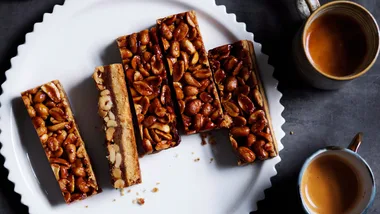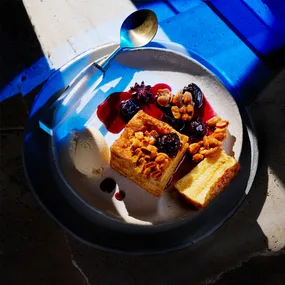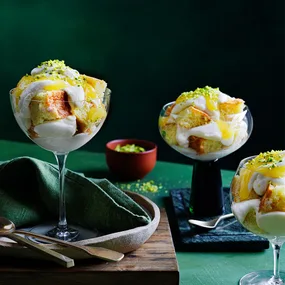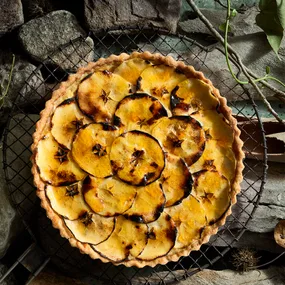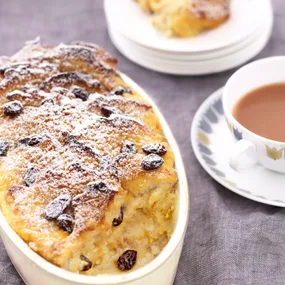I first played around with Black Forest cake when I worked at Rockpool Bar & Grill after seeing Heston Blumenthal make his Black Forest gâteau in the kitchen. The cake’s 10 layers had dark and white chocolate mousses, kirsch ganache, apricot pâte de fruit and more. Then I came across a version by Ramon Morató, the great Spanish pastry chef, which was white, not black. I thought it was really elegant and beautiful, so we put individual “White Forest” cakes on the menu.
The version I’ve done here has the more traditional light and dark layers, with a light and airy dark-chocolate sponge and a white kirsch mousse – a more classic gâteau and easy to accomplish at home.
Black Forest cake, or Schwarzwälder Kirschtorte, includes kirsch, but you could do a version with Grand Marnier and orange rind (though perhaps not under the same name).
The sponge
The sponge I like to use is very versatile – it can be baked thin to make a Swiss roll, or thicker to use, as I have here, for a layer cake. You want the sponge to be light but sturdy enough to hold the layers – using cornflour instead of plain flour helps with lightness, and whisking the whites separately and folding them in increases aeration.

Step 2.
I weigh all pastry ingredients. The ratio of yolks to whites can vary from egg to egg, for example, so giving a weight rather than a number means a more consistent result. Then whisk two-thirds of the icing sugar with the yolks on medium speed so by the time the whites are whisked, the yolk mixture will be ready. You want the eggwhites between soft and firm peaks; you won’t get a light cake if they’re too firm.
Once the eggs are whisked, you need to fold them together. Fold a third of the eggwhites into the yolks to lighten the mixture; you don’t need to be very delicate with this – it’s just to loosen up the yolks before folding in the remaining eggwhite. You only need to fold the eggwhite through a couple of times, then start adding the cocoa powder so you don’t overfold the mixture. Fold until everything is just combined, then divide the mixture between two baking trays, stud with cherries and bake them straight away so the batter doesn’t lose any air.
I use preserved sour morello cherries for this recipe, but Griottines cherries, if you can find them, are better because they’re steeped in alcohol, which gives a bit more of a kick.

Step 3.
The filling
For the filling, I use a mousse rather than a cream. It keeps in the fridge for three days, so it’s perfect to make ahead. The base of this mousse is a Swiss meringue – it’s used for fillings and icings because the eggwhites are heated to 70C, which makes the filling stable.
It’s important to cool the meringue to 30C before adding the whipped cream so it doesn’t melt. If the mixture is too cold, meanwhile, the gelatine may start to set, so whisk the cream while the meringue is cooling. Don’t whisk the cream until it’s firm, not even to soft peaks, or the mousse will be too firm and won’t settle in the tin evenly. Fold a little meringue through the gelatine mixture, then fold in the remaining meringue, and finally the whipped cream.

Step 6.
Assembling your Black Forest cake
When the cakes are ready, I cut a round from each that’s slightly smaller than the size of the cake ring I’ll be using to allow the mousse to fall down the sides of the cake.
Adding kirsch to the mousse gives a nice boozy tinge without making the sponge soggy. But if you prefer a boozier cake, and you’ll be serving it on the day it’s made, lightly brush the cooled sponge with kirsch before assembling it.
To finish the cake, I layer the sponge and mousse in a 6cm-deep, 24cm-diameter cake ring (you can also use a springform pan). Refrigerate the cake for a few hours, then decorate it as you like. This is the perfect dessert for a long Sunday lunch.

Step 9.

Step 11.

Step 12.
The recipe
Prep time 1 hr | Cook time 35 mins (plus making chocolate shavings, cooling, setting)
Serves 10-12
Ingredients
Method
Main
Note To make chocolate shavings, melt 250gm finely chopped dark chocolate (53% cocoa solids) in a bowl over a saucepan of simmering water, thinly spread with a palette knife on a marble slab or inverted heavy tray and set aside until firm and set (1 hour). Scrape chocolate away from you with a large chef’s knife to form shavings and set aside. If your cake ring is shallower than 6cm, you can line the sides of the ring with acetate sheet up to 7cm deep. If you don’t own a cake ring, use a springform tin. Acetate sheets, available from art supply shops, make it easier to remove the cake once it’s set.
Notes

